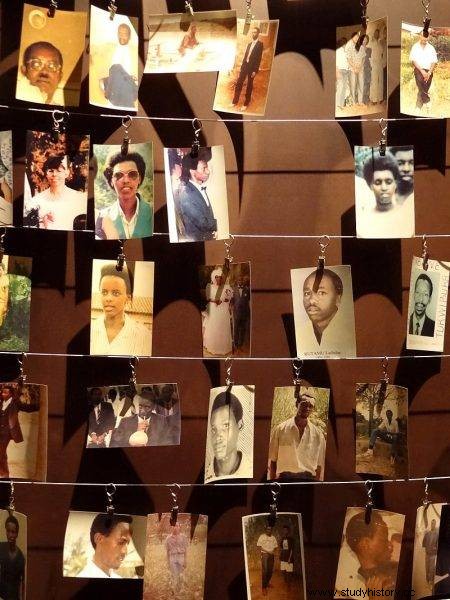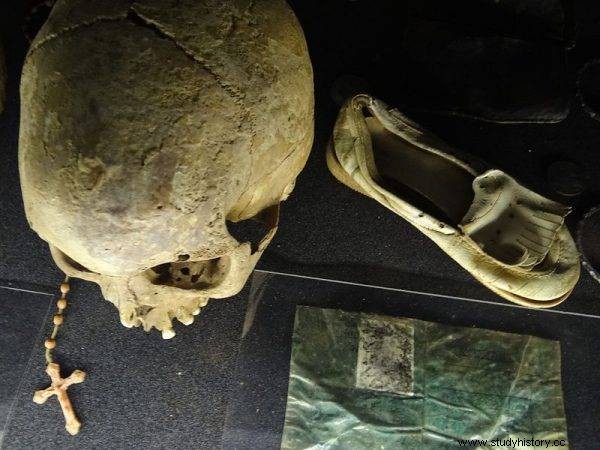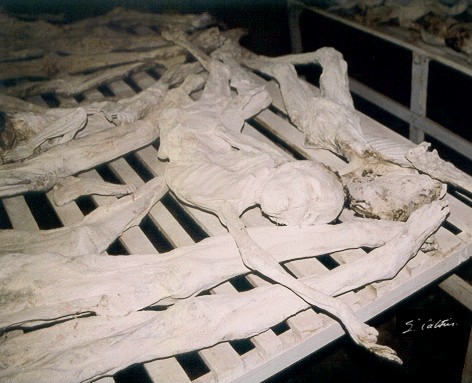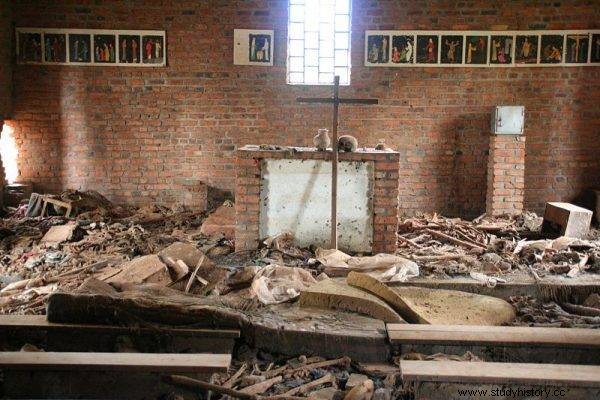On April 6, 1994, a plane was shot down with the President of Rwanda, Juvenal Habyariman, on board. The Tutsi people were accused of the attack. It was "a signal to start the unimaginable." With government money, entire containers of machetes were imported from abroad. The slaughter has begun, which the whole world was watching - idly.
Rwanda is a country with a population of 10 million in Central Africa, the size of an average Polish province. The economy is based on cultivation - mainly beans, sorghum and sweet potatoes. Agricultural technology is similar to the medieval one. Machetes or hoes can hardly be considered a sophisticated method straight from the 21st century. The state budget is almost non-existent and unemployment reaches 80% in some areas. It's hard to say anything about the health and education system, it functions only in a rudimentary scope. From the European point of view:there is none at all.
When the plane with President Juvenal Habyariman on board fell on April 6, 1994, it was known where to find the guilty. For months there had been a propaganda raid on Tutsis, known as vermin, on radio and television. With government money, entire containers of machetes were imported from abroad. Lists of Tutsi and moderate Hutu were created. A militarized militia was created, the Interahamwe, which consisted of ordinary workers, peasants, the unemployed, but also the military and the police.
Scheduled extermination
The reasons for this are the least important now. Suffice it to mention that the antagonisms between the Tutsi and Hutu peoples had lasted for many centuries. After Rwanda gained independence after World War II, like many former African colonies, the divisions became racial and political, resulting in many conflicts.
The Tutsis from their position as ruling "race" became subordinates, and the Hutus, who had been treated as subjects for generations, having occupied all strategic state offices, were finally able to take revenge on their fellow countrymen. Many Tutsis emigrated to neighboring countries, forming troops of the Rwandan Patriotic Front there to help regain lost power.
Eventually, there was a tragedy - on an unprecedented scale. Between April and July 1994, the Hutu killed approximately one million Tutsis. For a hundred days, they slaughtered ten thousand people a day. The merciless slaughter is all the more shocking as they did it in front of the whole world, when contingents of UN troops were stationed in Rwanda, whose task was to stabilize the tense situation.

Photos of the victims at the Kigali Memorial Center
The governments of the European Union countries and the USA knew exactly about the planned extermination. However, none of the soldiers of the organization intended to defend global peace even twitched a finger as entire families were machetically slaughtered, raped, massacred. The genocide in Rwanda showed just how rigid, dehumanized and cynical Western civilization is. It was a disgrace to the whole world.
Poles also served at the UN at that time. They got an order from the headquarters to wait and do nothing. "It's not our business, not our business" . The only activity of the UN troops was the rapid evacuation of all white people and foreigners working in offices, diplomatic missions, churches and monasteries. Nothing else. No one else was allowed to be saved from imminent death.
Rule number one:killing
In the Memorial Center in Gikondo, there are hundreds or even thousands of photos of children - from newborns a few months old to students. They have smiling or serious faces. Below the photos there are names, surnames and brief information about them. Françoise liked to eat eggs and chips; David wanted to become a doctor; someone else a lawyer, teacher, wife, father ... At the end, the type of death was written:beheaded with a machete; headshot; tortured to death; knife in the eyes; smashed against the wall; raped to death.
At the Kigali Memorial Center - the same wall with photos, only adults. Parents and grandparents of the children of Gikondo. They hang there "on a string like washed underwear". 250,000 civilians were buried in the gardens of the Memorial Center - a quarter of the victims from 1994. Bodies have been found for fifteen years in virtually every corner of the country.

Skull and personal belongings of the victims in Kigali
In roadside ditches, burnt huts, cloaks, swamps, cultivated fields, schools, hospitals, churches. "[...] there is no school, clinic, office in Rwanda, no road, alley or corner where no blood would spill from someone's neck." The swollen bodies were chased into the swamps, where the Tutsis tried to hide by the thousands. The whole country smelled of rot and blood.
To illustrate the scale of the genocide, Jan Hatzfeld cites figures:before April 1994, the mountainous region of Bugesera (especially Nyamata County) was inhabited by 119,000 people. "After all," about 50,000 people remained. "Five out of six Tutsis died in less than a month and a half."
The former torturers talk about those days as if they were recalling an interesting story among their friends. “Rule number one was killing. Rule number two was not there. It was an organization without unnecessary complications, ”say Rimini inmates.
"On the first day, an envoy from the commune councilor walked around the houses and told us to go to the rally immediately. There, the councilor stated that we had gathered to kill all the Tutsis without exception. It was straightforward, it was easy to understand. ”
"Inspirators planned and encouraged. Merchants paid and provided transport. Farmers stood guard and plundered. But when it comes to the slaughter, everyone had to go with a machete in hand and participate in it, at least they had to prove themselves. […] We complained about these great expeditions, we thought that it would be better to stay at home. We knew that those who came from far away came here to kill as many Tutsis as possible. As a matter of fact, we didn't like them, we preferred to do it among ourselves. ”
"On April 10, the mayor in a pressed suit and all the authorities called us to a meeting. They admonished us, threatened those who would like to mess up the job in advance, and the slaughter started without strict guidelines. The only rule was to continue to the end, keep the right rhythm, not spare anyone and plunder whatever you found. It couldn't be messed up. ”
Country of victims and torturers
Everyone remembers the first days and the entire organization of the genocide very well. They are unable to count their victims not so much because of their number, but because… they do not attach much importance to it. Many of the former torturers drove those days out of consciousness as if it were a nightmare or the result of an alien, external force.
At first, we were too busy to think. Later we got used to it too much. In this state, the thought of beheading our neighbors to the last did not matter to us. It was self-explanatory. They were no longer our good old neighbors, the ones who served us a pot of liquor in a cabaret, because they shouldn't be here anymore. They became redundant people, so to speak.
Many murderers recall 1994 with exceptional fondness:“We felt alive with this new job. We were not afraid that the chases in the swamps would exhaust us, and if someone was lucky in this job, he was really joyful. [...] Time was exceptionally favorable for us, because we used everything that we missed before. Primus every day, cow meat, bicycles, radios, metal plates, windows, everything. It was said that it was a happy season and that there would be no other such season. ”

Mummified bodies of victims
At a school in Murambi, in April 1994, thousands of Tutsi women, men and children were murdered. About 50,000 bodies are buried in mass graves under concrete slabs. Only 7 people survived this massacre. Some of the bodies were mummified. Eight hundred and forty mummies were selected and placed in the classrooms as evidence of what happened here. They are sprinkled with lime regularly so that they do not rot too quickly. Human monuments to inhuman evil.
They took me to the school where I used to teach. There is a screeching sound like in a slaughterhouse:a hundred women from the neighborhood. And hundreds of our neighbors. Tutsi women were undressed by Hutu women, who wanted to see what their men were sighing for. They screamed at our nakedness. They gave the bodies of victims prepared in this way to their husbands. And they were diligent to ensure that none of them died without pain. Bodies were thrown into school latrines.
Another memory:“They raped me long and brutally. My kids must have watched this. But it wasn't too bad anyway. Because others were forced to hold the mother's legs so that the murderer had easier access to her. And they didn't have the worst. Because it happened in our country that adolescent boys raped their mothers at the behest of the murderers. They beheaded a son when he penetrated the body of the one who gave him life. ”
Some women had to eat their babies in front of the crowd.
Exodus Hutu
There is no family in Rwanda that has not experienced such suffering, or has not caused it. There is no person in Rwanda who lives without such a stigma. This also applies to the clergy. Like UN soldiers, pastors were more likely to choose the role of observers than defenders. Sometimes executioners with the Word of God on their lips and a machete in their hands.
The white priests fled after the first skirmishes. Black priests became killers or they died themselves. God remained silent and the churches stank of the corpses we left inside. There was no place for religion in what we were doing. We briefly ceased to be ordinary Christians, we had to forget about our duties in catechism lessons. First of all, you had to obey orders. And God only then, long, long after that, to confess and do penance, when the work is done.
In the parish in Gikondo, where Polish missionaries worked, it was more important for the clergy to save the monstrance from the church than the parishioners praying there a moment earlier.
Some clergymen tried to help the Tutsis, while they died themselves, others, like priest Wenceslas Munueshyaka from the parish in Kigali, chose Tutsis from the crowd of believers, murdered and raped. Athanase Seromba of Nyange parish urged Hutu to demolish his church with bulldozers - with Tutsis bolted inside. When, after the murders, the victim hid in the Vatican, the authorities of that country refused to surrender him. He later returned to his country himself, where he was sentenced to life imprisonment.

About 5,000 Tutsi hiding there died in the Ntarama Church
After several months of incessant murders, rapes, and robberies, the Hutus began to rush in fear of the approaching troops of the Rwandan Patriotic Front. They looted what they could and tried on their own shoulders to transfer valuables to the refugee camps. About two million Hutus fled abroad after the massacres. Many of those who did not escape were murdered or captured by the vengeful Tutsis.
If anyone thinks that with the end of genocide the situation in the region has somehow calmed down, he is very wrong. The pressure of immigrants, not only civilians, but also soldiers pursued by the RFP, led to civil wars in which at least eight African countries were ultimately involved. In historiography, they are called the First and Second Congo Civil War and by 2008 they claimed over five million victims.
The latter is considered the bloodiest conflict after World War II. Its ending is only arbitrary, because there are still smaller or larger clashes there, in which the civilian population, women and children most often suffer. All with the unanimous silence of the rest of the world, of course.
Rwanda today
In Rwanda, the former torturers are neighbors. In one house in Gikondo lives a man who killed the entire family of the taxi driver across the street. “And now he is stroking my daughter on the head. She keeps saying, write it out, paint your grandma. My mom who had her head cut off. ”
Today in Rwanda there is no talk of Hutu and Tutsi. It's taboo. There is talk of Rwandans, one community. Everyone knows everyone there. Everyone knows the victim or the torturer. He is one or the other. If anything, mention is made of the Tutsis as victims. Never about Hutu because that's not correct.
The only ones who dare to tackle the Hutu theme are some Catholic clergy. Besides, the clergy always - openly or covertly - nurtured the divisions in Rwanda. During the reign of the Hutu regime, they gave good advice to the only right party, now they welcome oppressed former torturers under their wings as martyrs of history. They even talk about two genocides - linking this to marginalizing the victims among the Hutu people.
The problem is that this is perceived by many as a denial of the Tutsi tragedy. Anyway, to this day the clergy are supposed to favor the Hutu more than the other people. Priests cover themselves with divine judgments and infinite mercies - as cloudy in Rwanda's climates as the local swamps.
Rwanda - "the land of a thousand hills and a million smiles" - today is an insignificant corner of not too tempting tourist attractions. Its inhabitants have to deal with their traumas on their own. They try to erase from their memories something that cannot be displaced from memory, and the only people who try to unravel the still seeping wounds are journalists - probably the only people who do not let the world forget about the responsibility for the unnecessary death of millions of people.
